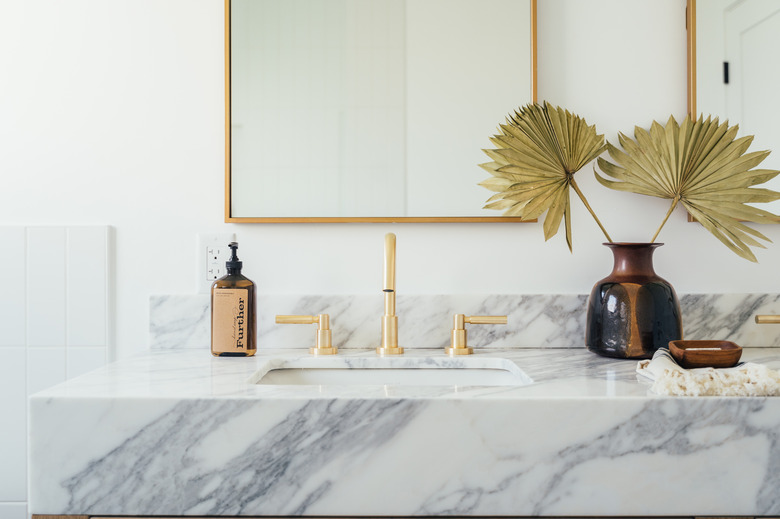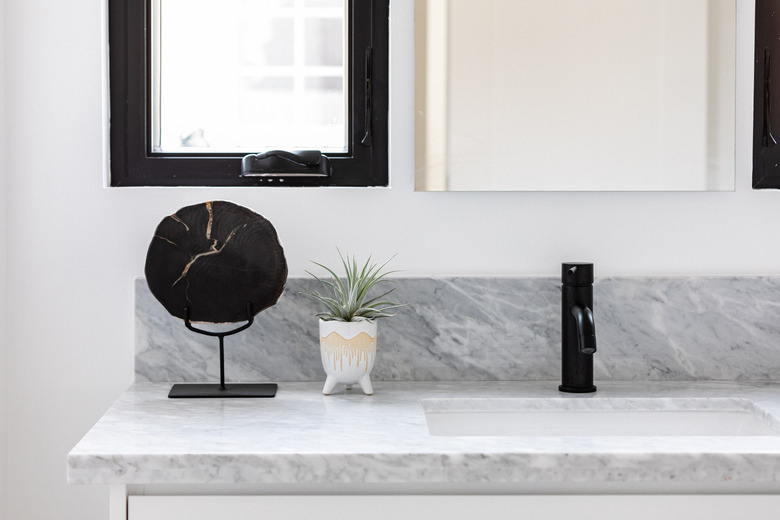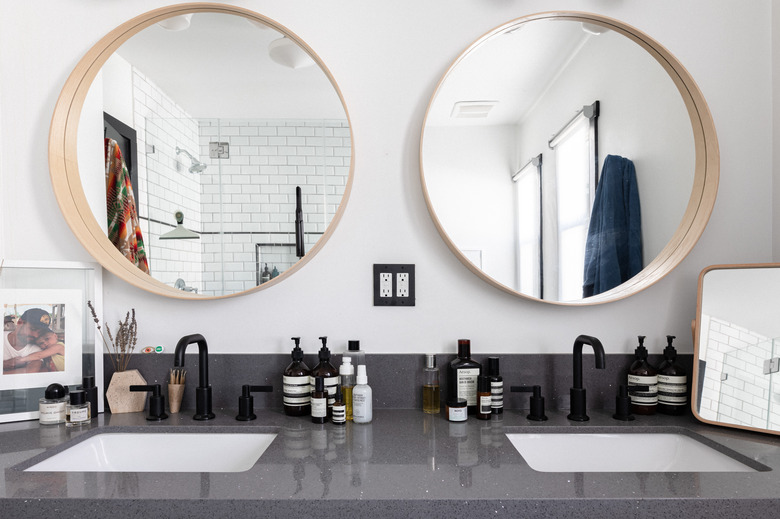How To Install An Undermount Bathroom Sink
An undermount sink really brings out the beauty of a stone or solid-surface bathroom countertop, and undermount bathroom sink installation isn't as complicated or difficult as you might think. Undermounts are also popular kitchen sinks, but because a kitchen sink is larger than a bathroom sink and has to support more weight, including a garbage disposal, installing an undermount in the kitchen can be challenging. An undermount bathroom sink installation, on the other hand, is a relatively easy DIY project, especially if you haven't yet installed the countertop, or you have the option of removing it.
Whether or not the countertop is attached to the bathroom vanity cabinet, you have to install the sink from underneath because that's the only way to align it, and proper alignment is key to a successful installation. The sink cutout can overhang the sink slightly (for a negative reveal), it can be flush with the sink or it can be recessed slightly (for a positive reveal).
In any case, even a slight misalignment will be instantly noticeable, and once the adhesive has set, you can't fix it. This means you have to support the sink while the adhesive sets, and you can do this from above with a bar clamp or from below with precut 2x4 lumber and shims.
Fastening an Undermount Sink to the Countertop
Fastening an Undermount Sink to the Countertop
Undermount sinks made of materials such as copper or stainless steel aren't very heavy, and you can secure these to the countertop with construction adhesive or even high-quality silicone caulk. It's risky to rely on just glue, however, if you're installing a heavier porcelain, cast iron or composite stone sink, and manufacturers usually supply clips for those that must be secured to the underside of the countertop with screws or epoxy cement. It's always important to read and follow the manufacturer's installation instructions if you don't want the sink to pull away from the countertop and eventually fall.
Manufacturers such as Kohler and Moen include mounting clips with most of their sinks, and you usually screw the posts for these clips into insets anchored into predrilled holes in the countertop. The opinions of installers vary concerning the use of sink clips. Ask the Builder recommends securing the sink clips with two-part epoxy, while Home RenoVision DIY doesn't mention clips at all and instead recommends securing the sink with nothing but a bead of pure silicone caulk.
Some porcelain sinks have a rim that's too thick for sink clips, so it's good to know how to do an undermount bathroom sink installation without them. Silicone caulk is a better sealer than it is an adhesive, so for a more secure installation, consider using construction adhesive such as Liquid Nails to hold the sink and consider applying a bead of silicone sealant later to keep water out. If you choose a sink that comes with clips, follow the manufacturer's instructions for using them.
Cutting Out the Sink Hole
Cutting Out the Sink Hole
If you're replacing an existing sink, the countertop already has a sink cutout, and you should choose a new sink that matches the hole. If you're using a new vanity top, it may be possible to cut the hole yourself, but it's not easy to get the edges and finish just right, particularly with natural stone. It's better to buy the sink and vanity top together to be sure that the sink fits the precut hole. Alternatively, if you have an unusual sink or you want the sink in a specific area of the vanity top, you may need to take the top to a countertop fabricator to have the sink hole cut. You'll also need to have one or more holes drilled for the sink faucet depending on the faucet type.
Things Needed
-
Denatured alcohol
-
Construction adhesive
-
100 percent silicone caulk
-
2x4 board (long enough to span across the sink cutout)
-
Drain assembly
-
Plumbers' putty
-
Faucet
-
Two faucet supply hoses
-
Drain tailpiece
-
P-trap assembly
-
Sawhorses
-
Rag
-
Caulking gun
-
Bar clamp
-
Tongue-and-groove pliers
-
Wrench
Warning
Before you begin your undermount bathroom sink installation, turn the water supply off to your sink to avoid leaks and flooding.
How to Do an Undermount Bathroom Sink Installation
1. Clean the Underside of the Countertop
Place the vanity top upside down on two sawhorses. Moisten a rag with denatured alcohol and wipe down the underside of the countertop around the sink cutout to remove dust and oils that will interfere with glue adhesion. Flip the countertop right side up so the sink hole is centered between the sawhorses.
2. Apply Adhesive to the Sink Rim
Using a caulking gun, apply a 1/4-inch bead of construction adhesive to the outer edge of the sink rim, keeping it as far as possible from the inside edge to avoid having it ooze into the sink bowl when you set the sink. If the rim is wide enough, it's a good idea to run a bead of silicone caulk about 1/2 inch away from the construction adhesive to make a watertight seal. You can also apply silicone to the gap between the sink and the countertop after you've set the sink and the construction adhesive hardens.
3. Position and Clamp the Sink
Remove the adjustable grip from a bar clamp, insert the bar through the sink drain hole, reattach the grip and hook it onto the bottom of the sink. Place a straight 2x4 across the sink cutout and hook the bar clamp onto it.
Get a helper to lift the sink while you tighten the clamp and bring the sink to within 1/4 inch of the countertop. Fine-tune its position and tighten more until the sink makes contact with the countertop. Make final adjustments while you can still move the sink, and when you're satisfied, tighten the clamp all the way until the sink won't move. Let the adhesive set overnight.
4. Caulk the Sink Edge
Apply an even bead of silicone caulk along the inside edge where the sink meets the countertop cutout. Carefully smooth the caulk with your finger for a finished look. Let the caulk cure as directed.
5. Install the Drain Assembly and Faucet
If you've set the countertop on sawhorses, you'll find it easier to install the drain assembly and faucet before you transfer the countertop to the vanity rather than afterward. Pack the underside of the drain strainer with plumbers' putty and use tongue-and-groove pliers to secure it with the gasket and retaining nut that come in the drain assembly kit. Secure the faucet to the countertop with the fasteners that come with it. Attach a flexible supply hose onto each faucet inlet, tightening the connection nut with a wrench.
6. Hook Up the Drain and Water Supply
Install the countertop onto the bathroom vanity. Screw the drain tailpiece onto the drain strainer (if this hasn't already been done) and install the P-trap assembly. Tighten the faucet supply hoses onto the shutoff valves using a wrench and then open the valves and check for leaks. Fill the sink and then empty it and watch for leaking connections in the drain assembly. Tighten any connections that leak using pliers.
References
- Ask the Builder: Undermount Kitchen Sinks
- YouTube: Moen – How-to Install a Stainless Steel Undermount Kitchen Sink
- YouTube: This Old House – How to Secure an Undermount Kitchen Sink | Ask This Old House
- Networx: Choosing an Undermount Bathroom Sink
- Kohler: Installation Guide – Beveled Stainless Steel Sinks
- YouTube: Home RenoVision DIY – How to Install an Undermount Sink


